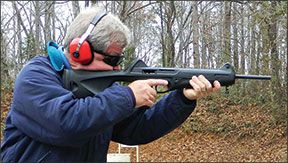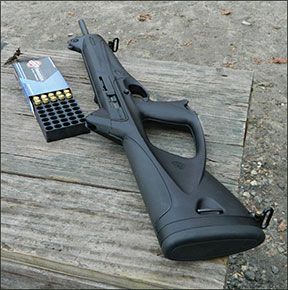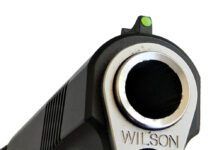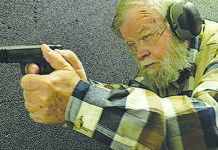In the past, the primary means of increasing handgun power has been to ‘Magnumize’ the cartridge, provide a longer barrel, or increase the diameter of the projectile. A means of improving the accuracy of the pistol was to add a shoulder stock. (Illegal in most applications today.) These expedients gave the revolver great practical accuracy. Effective power and range were increased by superior accuracy. Today, the pistol-caliber carbine takes the place of the shoulder-stocked pistol for defense, maximizing a pistol cartridge while taking advantage of modest recoil. For those who do not wish to deploy a full-power rifle for home defense or who desire to own a long gun with the ability to take the same magazine as the pistol, the pistol-caliber carbine has much merit. The average shot will be able to achieve much greater accuracy with the pistol-caliber carbine compared to a handgun. Handling at close quarters is good when the proper technique is employed. If need be, the pistol-caliber carbine is accurate enough to take out pests and predators up to 100 yards away.

288
A popular combination in the Old West was the 44-40 revolver and the 44-40 rifle. While much more compact, the 40 Smith & Wesson cartridge offers similar energy. In the case of the 40-caliber carbines tested, the ballistics of the 40 S&W cartridge move the pistol caliber carbine into small-game and even deer-sized-game territory. This conclusion is based upon a comparison of energy figures to the old standby carbine cartridge, the .44-40 Winchester, a proven game getter. The modern 40 S&W is more widely available and offers superior performance when similar carbine-length barrels are compared. Plus, the compact 40 S&W cartridge is available in a semi-automatic action and with a variety of bullet designs.
So loaded, the 40-caliber carbine hits hard. As an example, the Beretta CX4 Storm PX4 JX4P415 40 S&W in this test generated a whopping 676 foot-pounds of muzzle energy with a Cor-Bon 150-grain JHP loading.
The Kel-Tec was not far behind with 1391 fps and 644 foot-pounds of energy with the same loading. Compare that to about 475 foot-pounds of energy from a pistol, and you see the carbine offers an advantage. Even the lowest-energy cartridge we clocked and calculated energy for, the Black Hills 180-grain FMJ training round, exhibited 510 foot-pounds of energy from the Kel-Tec carbine. That is a lot of smash in a light and controllable package. Looked at another way, the 40 carbine offers about the same power at the muzzle as a 10mm pistol. This means that with the 40-caliber carbine you have 10mm power on tap but in a much more accurate delivery system. Compared to the 9mm carbines we’ve tested before, the 40s offer considerably improved ballistics with little increased recoil.
But why a pistol-caliber carbine when the AR-15 is around? The 223 rifle is more powerful; however, raw power isn’t everything, and the 40 S&W is plenty powerful for home defense. Witness the recent unfortunate incident in Zanesville, Ohio, in which cops were forced to put down large and dangerous animals to prove the 40 caliber is up to the task, if properly delivered. So, with enough power for home defense, what else favors 40 carbines? The 223 exhibits tremendous muzzle blast inside the home. And while no one considers the 223 a hard kicker, the 40 carbine generates about 75% of the recoil of the 223.
Moving to another comparison, the carbine kicks much less than the shotgun. The 40-caliber carbine handles quickly, with less recoil, than a 12 gauge, and in a worst-case scenario has better long-range capability.

288
Those are where these carbines from Beretta and Kel-Tec can fit in your self-defense needs. Now let’s see if the carbines are able to stand on their own merits.
Kel-Tec Sub-2000 40 S&W
Our first impression was that the Kel-Tec is light enough at 4 pounds. Like the Storm, this carbine is blowback operated; that is, the bolt simply recoils to the rear off the chamber, so there is no gas operation involved. This makes for a simple system. The tubular stock contains the carbine’s recoil spring.
The Kel-Tec is constructed primarily of Zytel. An interesting part of the design is the Kel-Tec’s hinged component that allows the carbine to be quickly folded and stored away. Simply press the trigger guard down and press the barrel up, swinging the barrel over the receiver and locking it into the stock. Despite this ability, our shooters found the carbine remains rigid when in the firing position. The Kel-Tec isn’t a true takedown rifle, as it remains in one piece, but the concept is the same.
The Kel-Tec folds easily into a truck gun, but unlike the folding stock AK and the like, the Kel-Tec doesn’t fire when folded. The folding option is pretty neat in many ways, but in the end, it is a convenience, not a tactical advantage. If you like storing the Kel-Tec folded in the gun safe or attic, it takes up less room, but if it is behind the truck seat and folded, it is slower into action than a conventional carbine.
The Kel-Tec features a crossbolt safety that blocks the trigger and sear when activated. The sights are good examples of combat sights — quick to pick up — and the red-plastic front insert was particularly welcome.
The operating rod is on the tubular-steel buttstock. This isn’t the fastest system for making the carbine ready, in our opinion. It is OK for range use or if you were going to cock the gun and then stand guard duty. But we do not recommend keeping any long gun at home ready with its chamber loaded. Accessing the Kel-Tec quickly and racking the bolt takes practice. You cannot do this easily once the carbine is shouldered, we thought.
The crossbolt safety is positive in operation and no impediment was experienced in using this safety. The trigger action is a bit spongy, but a spongy carbine trigger is much easier to control than a spongy pistol trigger. There is more leverage.
We have mentioned before that there is a lot of firing that goes on with anything we test. In gaining an impression of a firearm, we shoot it with various loads, often left over from another test. For familiarization shooting, these carbines were fired at man-sized silhouette targets at typical engagement ranges of 7 to 12 yards. They were also fired for shooting impressions at up to 100 yards. The few magazines of Blazer 180-grain FMJs we fired in the 2000 suffered a 30% failure to function. Then we re-read the owner’s manual, where it clearly states not to use aluminum-case ammunition. While not completely fair to complain about the Blazer ammo’s failure, the Storm is fully compatible with the aluminum-case ammunition. Both carbines were also fired with a half box each of Wolf steel-cased ammunition, and each fired just fine.
The majority of the combat-type shooting was undertaken with the Black Hills 180-grain FMJ load in the remanufactured line. The Kel-Tec functioned properly through 50 rounds of this cartridge. This load was used in firing rapid fire and executing combat drills head shots from 5 to 10 yards. The Kel-Tec proved fast on target. Control in rapid fire was good. Trigger reset was good. The stock and forend configuration cramped the raters with longer arms, but the carbine was not uncomfortable. There is an optional 1-inch spacer to increase the length of pull, but we did not have this item on hand. It would help.
Moving to firing offhand at 25 yards, X-ring hits were not difficult, but required more concentration. While not a hard kicker, the momentum the 40-caliber cartridge develops adds up during a range session, a problem we feel is compounded by the steel rod that serves as a stock, which isn’t very comfortable, our shooters said.
The Kel-Tec’s recoil is much different than the Beretta. As one rater noted, there is a lot going on when the carbine fires and it feels as if it is battering itself. There were no malfunctions of any type after we finished the Blazer loads as far as feed reliability.
The Kel-Tec bolt does not lock open on the last shot. We like a gun that tells you when it is empty, but this is simply part of the price of economy. However, on three separate occasions the last spent case was caught between the bolt and the ejection port. While not a stoppage in this sense, this certainly wasn’t ideal. When switching magazines, since there is no hold-open or bolt-stop feature, the spent magazine is removed and a fresh magazine inserted. Then the bolt is racked. The spent case caught by the bolt added a complication and could have caused a stoppage had we not noticed it. It would have been possible to insert a fresh magazine, rack the bolt and catch the spent case in the chamber rather than chambering a fresh round.
In firing off sandbags at the bench, the Kel-Tec proved accurate enough for personal-defense use well past 25 yards. Groups at 25 yards ranged from 2.5 to 3 inches, about the same as service-grade-pistol accuracy, but that accuracy was easier for shooters of varying experience to deliver.
Our Team Said: The Kel-Tec is worth the modest price. It is reliable, accurate enough for personal defense or predator control at reasonable range, and it uses Glock magazines. The preliminary hiccup with Blazer loads and its inferior handling compared to the Beretta caused us to rate the piece down a notch below the other rifle.
Beretta CX4 Storm PX4 JX4P415 40 S&W, $915
Our loaner Storm came courtesy of our friends at Full Armor Firearms in Houston (FullArmorFirearms.com). The Storm differs considerably from the Kel-Tec in that it uses a thumbhole stock and does not fold. The stock is polymer and so is the receiver. The Storm is just slightly longer, a half inch, than the Kel-Tec when the Kel-Tec is ready for use, although stock options and the Kel-Tec stock insert may change this.
Elsewhere, the Storm has good features, including excellent adjustable sights. There are two rear apertures for short- and long-range use; simply flip up the one you wish to use. The sights may be folded down for optical-sight use. This is a great advantage for the Storm. A red-dot sight such as the Bushnell First Strike just might be appropriate for the Storm carbine.
At almost 6 pounds, the Beretta is heavier than the Kel-Tec. This isn’t much of a drawback in home defense, and as a result, the felt recoil of the Beretta was slightly lighter. The straight-to-the-rear recoil has a different feel due to the stock configuration of the Storm.
The controls of the Storm were well placed. The crossbolt safety was neither better or worse than the Kel-Tec. The magazine release worked fine. We like the cocking lever better than the Kel-Tec cocking rod. The cocking handle of the Storm is reversible. The Kel-Tec is ambidextrous by design, but we still like the Storm better.
We really liked the Storm’s bolt release. It is handy and falls under the thumb, readily for rapid manipulation. The Storm locks the bolt open on the last shot, something we really like and appreciate more when we do not have it, as with the Kel-Tec. The thumbhole stock takes some getting used to, but it felt much more comfortable than the Kel-Tec after we adjusted to it.
We were able to adjust the length of pull from 13 to 14 inches with the Beretta, a nice touch that accommodates varying sizes of testers. Simply remove the buttpad and unscrew the supplied spacer for a shorter length of pull, if desired. Also, another spacer may be ordered from Beretta to increase the length of pull by another inch. We did not have this one on hand, but none of the raters needed it. That is a lot of adjustment range, and though the changes are semi-permanent when compared to the AR-type adjustable stock, this arrangement leaves the stock quite rigid.
At the range, the Storm ate up the Blazer ball the Kel-Tec choked on. Also, steel-cased ammunition functioned fine. Firing it in combat runs, our shooters said the heavier Storm handled better and turned in superior rapid-fire groups. We had one shooter-induced malfunction with the Storm. The rater did not completely seat the magazine. However, somehow the first round fed and fired, and then the magazine slipped down in the magazine well. The magazine must be seated in the receiver well properly, of course.
During a side test, the carbines were loaded with Black Hills ball and fired with one hand. This isn’t something you should do in a defensive situation, but then who knows what may occur? You might be retreating to the safe room with a child under one arm. Firing the two pieces with one hand, we thought the weight distribution of the Kel-Tec helped it feel more like firing a pistol. The Storm was more stable if held and fired at hip level. Shooters said they could easily handle the Kel-Tec with one hand due to its light weight and distribution of that weight. The Storm is easier to handle than a true rifle-caliber carbine.
Firing off the bench, we felt that the Beretta had the superior sights for accurate fire. Recoil was less of a factor because the Beretta is heavier and because it has a better stock design. The shooter can achieve cheek weld with the Storm, but not with the Kel-Tec.
One anomaly in the Storm we noted, 180-grain loads showed a tendency to put one bullet almost an inch away from the others. We fired five-shot groups as in pistol shooting rather than traditional three-shot rifle groups. Despite its tendency to exhibit the 4+1 syndrome (four shots in a tight group and one out), the Storm produced excellent accuracy. By loading the magazine with six rounds and firing the first round into the berm, we could cure the 4+1 problem. But this would have been unfair because the Kel-Tec did not demonstrate this condition and the Storm did not show it with all loads. We’re still scratching our heads because we didn’t get flyers with the 150- and 155-grain loads.
Our Team Said: Based on its smoothness, superior controls, excellent accuracy, and reliability, the Storm gets our top mark. As a bonus, the Storm came with a very nice carrying case compared to the Kel-Tec’s cardboard box.
Written and photographed by R.K. Campbell, using evaluations from Gun Tests team testers. GT





























